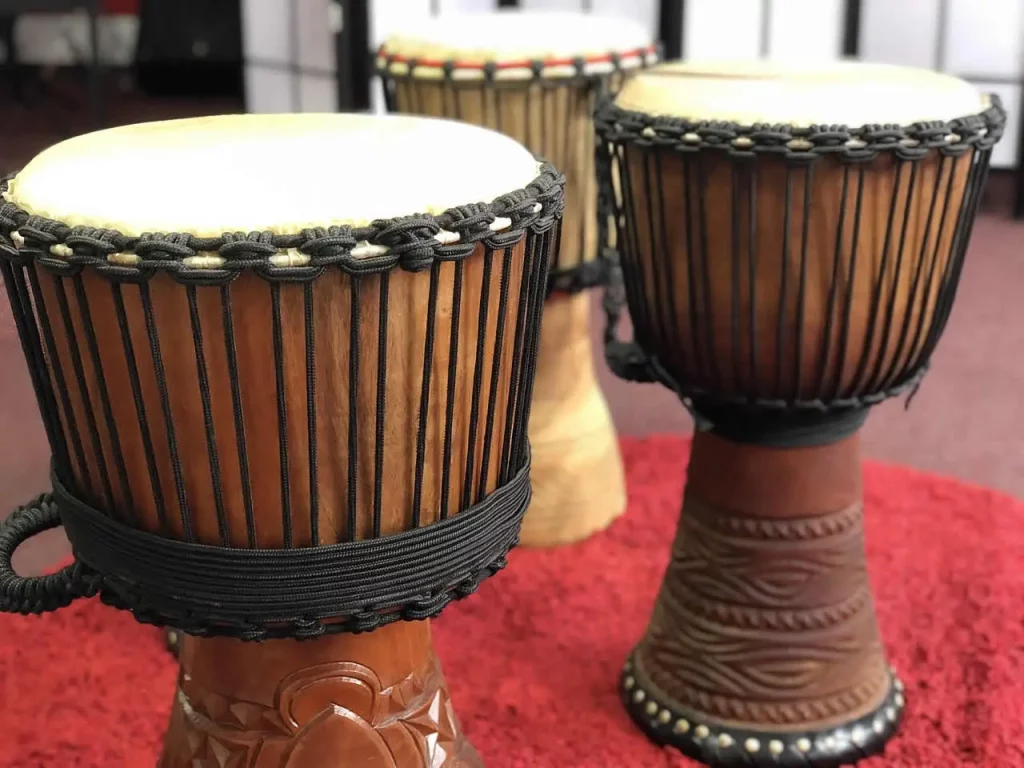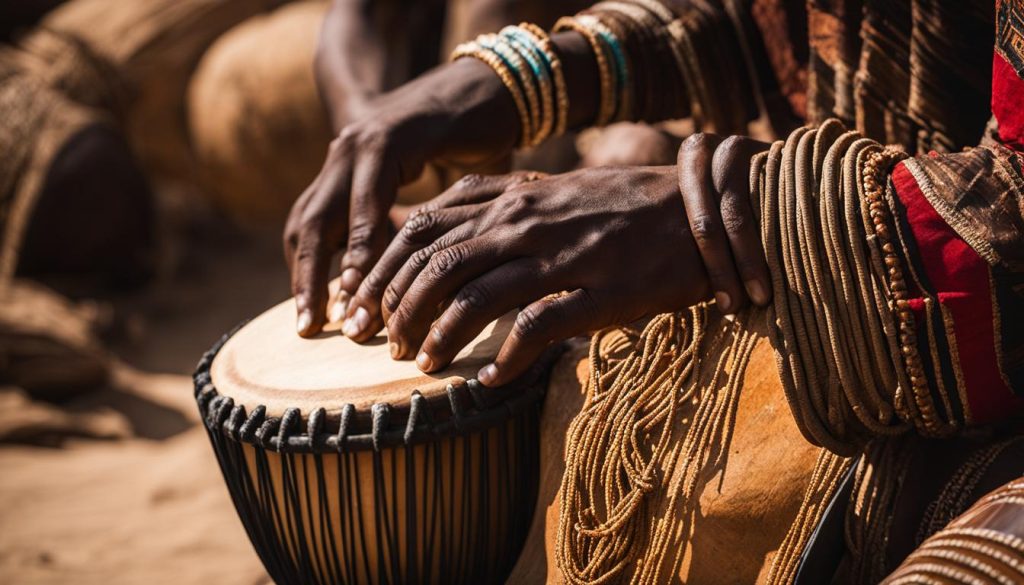Welcome to our step-by-step guide on how to make an African djembe drum. If you’ve ever wanted to create your authentic percussion instrument, now’s your chance!
I will walk you through the djembe drum-making process, providing you with all the information you need to craft your very own masterpiece.
The djembe drum is a traditional West African instrument known for its deep, resonant sound and unique design.
By following our guide, you’ll learn how to construct the drum using everyday materials and techniques.
Whether you’re a seasoned craftsman or just starting, this step-by-step guide will ensure you have a rewarding and educational experience.

Content
Materials Needed for Building a Djembe Drum
Building a djembe drum requires several materials that will be used throughout the creation process. Here is a list of the essential materials you will need:
- Two paper cups
- Scissors
- Sticky tape
- Old newspaper
- Flour
- Water
- Paint
- Paintbrush
- A balloon
- A rubber band
- A mixing bowl
- String
- PVA glue
These materials will be utilized at various stages of the drum-making process, from constructing the base with the paper cups and papier-mâché to adding the plastic bag and string for the drumhead and decorative elements.
Ensure you have all these materials ready before you begin crafting your djembe drum.
| Materials | Quantity |
|---|---|
| Two paper cups | 1 set |
| Scissors | 1 pair |
| Sticky tape | 1 roll |
| Old newspaper | Several sheets |
| Flour | 1 cup |
| Water | 1 cup |
| Paint | Assorted colors |
| Paintbrush | 1 |
| A balloon | 1 |
| A rubber band | 1 |
| A mixing bowl | 1 |
| String | Several yards |
| PVA glue | 1 bottle |
Traditional African Drum-Making Techniques
Traditional African drum-making techniques have been passed down through generations and involve a meticulous process of using natural materials to create drums that produce a resonant sound.
These techniques showcase the rich cultural heritage and craftsmanship of African communities.
The primary materials used in traditional African drum-making are:
- Wood: The drum shell is carved from a solid piece of hardwood. Different types of wood are chosen based on their density, durability, and tonal qualities.
- Animal Skins: The drumhead is typically made from animal skins, such as goat, cow, or antelope. The selection of skin depends on the desired sound and availability in the region.
- Ropes: Ropes made from natural fibers, such as jute or sisal, are used to secure and tension the drumhead. The weaving technique and tension of the ropes significantly impact the drum’s sound.
The traditional African drum making process involves the following steps:
- Carving the Drum Shell: A skilled artisan carves the drum shell from a solid piece of wood, shaping it into the desired size and form. The shell’s dimensions and design vary based on the specific drum type and regional traditions.
- Preparing the Animal Skin: The chosen animal skin is cleaned, stretched, and treated to ensure its suitability as a drumhead. It is then cut into a circular shape that matches the diameter of the drum shell.
- Attaching the Drumhead: The prepared animal skin is carefully placed over the open end of the drum shell. The drum maker secures it tightly using ropes woven in a specific pattern, creating tension that influences the drum’s pitch and resonance.
- Tuning the Drum: The drum maker adjusts the tension of the ropes to achieve the desired pitch and tone. This requires years of experience and a keen ear for sound.
- Decorating the Drum: The drum is often decorated with intricate carvings, paintings, or symbolic patterns that represent the cultural significance of the drum and its community.
These traditional African drum-making techniques vary across different regions, reflecting the diverse cultural identities and musical traditions found throughout the continent.
The craftsmanship and artistry involved in creating these drums have made them highly valued not only as musical instruments but also as cultural artifacts.

Assembling an African Djembe Drum
Assembling an African djembe drum is a fascinating process that requires a few key steps. By following these instructions, you can create your very own djembe drum that is ready to play.
Gather the Necessary Materials
Before you start assembling your djembe drum, make sure you have the following materials on hand:
- Two paper cups
- Scissors
- Sticky tape
- Old newspaper
- Flour
- Water
- Paint
- Paintbrush
- A balloon
- A rubber band
- A mixing bowl
- String
- PVA glue
Construct the Drum Base
To begin, tape the two paper cups together, ensuring they are firmly secured. This will serve as the base of your djembe drum.
Next, it’s time to create the drum shell using a papier-mâché technique. Mix equal parts flour, water, and PVA glue in a mixing bowl to create a paste-like consistency.
Tear strips of old newspaper and dip them into the papier-mâché paste. Apply the strips to the taped cups, covering them completely.
Layer the strips in different directions to create a sturdy structure.
Allow the papier-mâché to dry completely. This may take a few hours or overnight, depending on the weather conditions.
Paint and Decorate the Drum
Once the papier-mâché is dry, it’s time to bring your drum to life with paint and decorations. Start by painting the drum base with your desired color. White is a popular choice for an authentic look.
Let the paint dry before adding decorative elements. Consider traditional African patterns or personal designs to make your drum unique.
Using a balloon, cut out a circular piece from a plastic bag that will serve as the drumhead.
Stretch the plastic bag over one end of the cups and secure it with a rubber band. This will create a distinctive sound when played.
For added stability and decoration, wrap string around the drum, creating decorative elements around the middle and top sections.
Your African Djembe Drum is Ready!
By following these steps, you have successfully assembled your very own African djembe drum. Now, it’s time to grab some drumsticks and start playing!
Tuning and Finishing a Handmade Djembe Drum
Now that you know how to make an African djembe drum, tuning and finishing a handmade are crucial steps to achieve the desired sound and aesthetics.
The tuning process involves adjusting the tension of the drumhead’s ropes, which directly affects the pitch and tone of the drum. To tune your djembe drum, you can tighten or loosen the ropes in a specific sequence or pattern.
By experimenting with different rope tension, you can find the perfect balance that produces the rich and resonant sound characteristic of the djembe.
Finishing touches on your handmade djembe drum can include adding decorative elements to enhance its visual appeal. You may choose to incorporate beads, intricate designs, or even paint the drum shell in vibrant colors.
These additions not only add beauty but can also serve as a reflection of your style and creativity.
Remember that the finishing touches should complement the drum’s traditional African roots and enhance its overall appearance harmoniously.
Proper tuning and finishing techniques are paramount in creating a high-quality, authentic African djembe drum.
By carefully adjusting the rope tension and adding tasteful decorative elements, you can finesse your handmade drum to its fullest potential.
The result will be a truly remarkable instrument that not only produces captivating rhythms but also encompasses the rich cultural heritage of the djembe.
